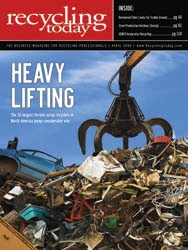The U.S. steel industry may have seen darker days in the past 10 years, but the severity of the market contraction that has occurred during the past several quarters has taken even the most bearish forecasters by surprise.
Dan DiMicco, CEO of Charlotte, N.C.-based Nucor Corp., one of the most successful steel manufacturers in the United States, during a recent quarterly report, said the company’s earlier expectations of a modestly better first quarter were based on the assumption that reduced inventories would be enough to bring better balance to the market.
"Our revised guidance for a first quarter loss reflects continued deterioration in economic and market conditions," DiMicco says. "Customer demand has continued to weaken, with resulting downward pressure on orders, production rates and steel pricing in all of our product lines."
DiMicco said Nucor’s steel mill utilization rate was expected to decline to nearly 43 percent in the first quarter from 48 percent in the fourth quarter of 2008. "The dramatically lower production has further slowed the rate at which our sheet mills are consuming higher cost iron units, in particular pig iron inventories, which were purchased prior to the collapse in both the economy and scrap/pig iron pricing in last year’s fourth quarter," he said.
"If these current production rates continue, the overhang from the high-cost pig iron will impact our results through the second and third quarters of this year," DiMicco continued. "The impact from higher-cost scrap should disappear during the second quarter. Any improvement in order entry and operating rates will speed up our raw material destocking process with a corresponding improvement in earnings."
DiMicco also pointed out what many long-time steel producers have seen in the past two quarters: "The unprecedented speed and magnitude of the global economy’s decline to depressed levels not seen in our lifetime have presented severe challenges in 2009. The economy has fallen off a cliff—and there is no visibility as to the timing of the recovery."
BRUTAL SCENE
This public declaration by one of the standard bearers of the domestic steel industry caps several months of brutal industry news. With few exceptions, U.S. steel mills have been cutting production, with many steel companies closing down mills for the foreseeable future.
However, the problems in the steel industry are not limited solely to the North American market. Steel companies throughout the world have been slashing production, closing mills and taking aggressive steps to attempt to balance supply and demand. But, as one steel industry watcher notes, "It is like trying to catch a knife."
It may be a well-worn cliché, but the sudden erosion of steel industry fundamentals has industry analysts scrambling to figure out how pronounced the slump will be.
The lack of clarity in the overall market has been most challenging. The uncertainty about the financial bailout packages that are being introduced, not only in the United States, but also around the world, are adding to the confusion.
Prices, which only a few months ago were at fairly robust levels, dropped by more than 50 percent almost overnight.
The domestic auto industry, a primary consumer of steel, has been struggling to dodge Chapter 11 or worse, while the construction sector has been hammered by recessionary forces. Residential construction has slowed dramatically, and even optimistic forecasts don’t have housing rebounding until next year.
Reflecting the challenging environment for the automobile industry, a recent headline from CNN, as reported by Canaccord Adams, notes that for the first time since 1945, fewer new cars will be purchased in 2009 than those turned in to scrap yards. With auto sales now down to 10 million annually (from a high of approximately 17 million), debate centers on whether there was an excess supply of vehicles, or an auto buying bubble. Some industry analysts argue that even if pent-up demand for new cars is building now, the auto industry is unlikely to return to the sales levels seen earlier this decade.
The stimulus package has a host of infrastructure-related programs that will likely boost steel demand. However, how quickly this money will be available for projects is a topic for debate. Some skeptics have said that it will take two years at the earliest before stimulus money is used for these purposes.
Mike Locker, a steel industry analyst with Locker Associates LLC, New York City, says he feels that some of the stimulus money will hit the steel industry sooner rather than later. "I think the money will reach us this year," he says. "It should benefit the long products side of the industry," he adds.
PRODUCTION REDUCTION
Even the most optimistic bull would be hard pressed to find positive news for the steel industry in today’s economic climate. The question now is whether the market will decline further or if it has stabilized, albeit at lower numbers.
As bleak as the market may be, there do not appear to be any signs of a turnaround in the near term. Capacity levels, which were hovering around 90 percent only last year, have plummeted, with some countries reporting capacity utilization rates of less than 50 percent. According to the most recent figures from the World Steel Association, Brussels, Belgium, world crude steel production for the 66 countries reporting to the organization was 84 million metric tons in February 2009, a 22 percent drop from February 2008.
In fact, only Iran and China reported an increase in production between February 2008 and this February. The largest steel producer in the world, China, increased its steel production by slightly less than 5 percent in February 2009 relative to the same time last year.
A report by IKB Deutsche Industriebank, Dusseldorf, Germany, notes that steel production in January of 2009 dropped by approximately 25 percent compared to January of 2008, with production in major western regions dropping by up to 50 percent.
For February, IKB notes that "world steel prices decreased between 3 [percent] to 8 percent compared to the previous month. On the other hand, European prices showed only a slight decline. However, last year’s levels were partially undercut by up to 10 percent." IKB concludes, "Thus, production cutbacks of the steel industry have, at least, in Europe had the desired effects."
TROUBLE IN CHINA?
While China has seen an increase in steel production in February of this year, that does not mean the rest of 2009 will show upward momentum. A report by the China Iron and Steel Association (CISA) notes that many Chinese mills restarted their furnaces early this year, with the expectation that demand would pick up by the first quarter. However, as the challenges facing the steel industry lingered on, Chinese steel mills ended up inventorying much of the steel that they produced.
With that in mind, some analysts say steel product exports from China may decline by as much as 80 percent this year, far steeper than an earlier forecasted decline of nearly 50 percent.
The CISA reports that the 71 largest Chinese steel mills posted an aggregate loss of more than $150 million in January, with expectations that the losses may accelerate.
Peter Marcus with World Steel Dynamics, Englewood Cliffs, N.Y., expresses a pessimistic view as well. In a recent report, he writes: "Hot-rolled band prices seem to be in a phase of accelerating decline, even though they are already down substantially. To make matters even worse for the mills, shipment levels remain extraordinarily depressed in many countries and on the world export market—with few signs of a sizable improvement as of late February 2009."
Marcus adds, "The decline in apparent steel demand in 2009, when measured from the peak annual rate in the second quarter of 2008, will be huge. On this basis, global apparent steel demand in 2009 may be down 29 percent—composed of a decline of 40 percent in the Advanced Countries, 30 percent in the non-Chinese Developing World and 17 percent in China (where the outlook is deteriorating)."
The domestic steel market also has shown a near collapse in shipments. According to the most recent figures reported by the American Iron and Steel Institute (AISI), Washington, D.C., shipments for the first month of 2009 posted a decline of more than 50 percent. AISI reports that for the first month of this year, U.S. steel mills shipped 4.6 million net tons, a 50.5 percent decrease from the 9.2 million net tons they shipped in January of 2008. This figure also represents a 0.8 percent decrease from the 4.6 million net tons domestic steel mills shipped in December 2008.
It appears world steel production could experience further declines throughout 2009 unless the various economic stimulus packages that have been introduced begin to deliver on their promises.
The author is senior and Internet editor of Recycling Today and can be contacted at dsandoval@gie.net.

Explore the April 2009 Issue
Check out more from this issue and find your next story to read.
Latest from Recycling Today
- Aqua Metals secures $1.5M loan, reports operational strides
- AF&PA urges veto of NY bill
- Aluminum Association includes recycling among 2025 policy priorities
- AISI applauds waterways spending bill
- Lux Research questions hydrogen’s transportation role
- Sonoco selling thermoformed, flexible packaging business to Toppan for $1.8B
- ReMA offers Superfund informational reports
- Hyster-Yale commits to US production





